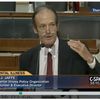The shooting of two Pentagon guards by John Patrick Bedell, a mentally ill man with untreated bipolar disorder, points to the inadequacy of psychiatric practice. But it's an inadequacy you can help fix.
According to The Daily Inquirer
People who are close to John Patrick Bedell are saying he was a troubled man who "sank deep into mental illness and anti-government rants."... "The family tried over and over to get him into some kind of treatment, but because he was an adult, they were restricted. Patrick himself was in some sort of denial."
In other words, he was so mentally ill, he didn't know he was mentally ill. But according to the American Psychiatric Association that's not a mental illness at all.
The APA released a draft Manual (DSM-V), proposing what should be defined as a mental "illness". As Sally Satel pointed out in the Wall Street Journal, the author's of the draft came up with lots of ways to get more worried-well "diagnosed." But as is too often the case, they've ignored some issues important to the seriously mentally ill.
It is well known to parents of people with schizophrenia and bipolar, that when their loved ones are off medications, they can deteriorate to the point where they don't even know they're sick. You can stand around, and tell a floridly schizophrenic woman that there are no zombies in the room, not a world-wide plot to kill her; and the reaction will be, "Yes there is". That's what likely happened to Mr. John Bedell, the Pentagon shooter: his brain was so dysfunctional from mental illness, it lost the capability to recognize he was sick.
This is the result of anosognosia and most likely caused by a problem in the brain's right hemisphere. Dr. Xavier Amador wrote, I Am Not Sick I Don't Need Help, specifically to teach families the workaround for their mentally ill relative who does not believe they are sick. He remains the nation's leading researcher on the subject and has written extensively in Schizophrenia Digest on the issue.
The APA recognized anosognosia as far back as 2000, but left anosognosia out of their most recent draft manual, according to Dr. Amador's Leap Institute.
According to the Treatment Advocacy Center's great collection of scientific articles on this, it is a major cause of what little violence there is among the mentally ill
The failure to include anosognosia is inexcusable and may have led to the shooting of the Pentagon guards.
It is a real disorder, suffered by real people who deserve real help. Getting it included in the DSM will lead to more research on treatment, heightened awareness of the issue, and ultimately, hopefully, it's elimination. This keeps patients and the public safer.
Fortunately, the APA does allow the public to comment on their proposals. They just don't make it easy.
Let the APA know that the DSM-V should recognize anosognosia as a common feature of schizophrenia, but (consistent with current research) also acknowledge its frequent appearance in cases of bipolar disorder. Here's how:
1) Log onto http://www.dsm5.org/Pages/Registration.aspx;
2) Register (and remember your user name);
3) Receive a password by email;
4) Return to the site and click on "Proposed Draft Revisions to DSM Disorders and Criteria";
5) From the right side of the screen, choose "Participate." Type in user name and password;
6) Click onto "Schizophrenia and Other Psychotic Disorders;"
7) Choose the last listed item, "Schizophrenia;"
8) Fill in comment box at bottom entitled, "My comments to the Proposed Revisions to Schizophrenia". Urge the APA to recognize anosognosia as a common manifestation of both schizophrenia and bipolar disorder.
